Business Finance Report: Budgeting Approaches and Analysis
VerifiedAdded on 2023/06/09
|9
|1515
|68
Report
AI Summary
This report, focusing on business finance, examines the benefits of budgeting for business development and the key areas addressed by traditional budgeting methods. It explores the appropriateness of the traditional approach and presents alternative budgeting approaches, such as Activity Based Budgeting (ABB), Zero Based Budgeting (ZBB), and Rolling Budget, along with their respective advantages and potential problems. The report then provides a recommendation for Neo Plastics Ltd, suggesting the use of ABB based on the company's manufacturing process, and concludes by referencing relevant literature on the topic.
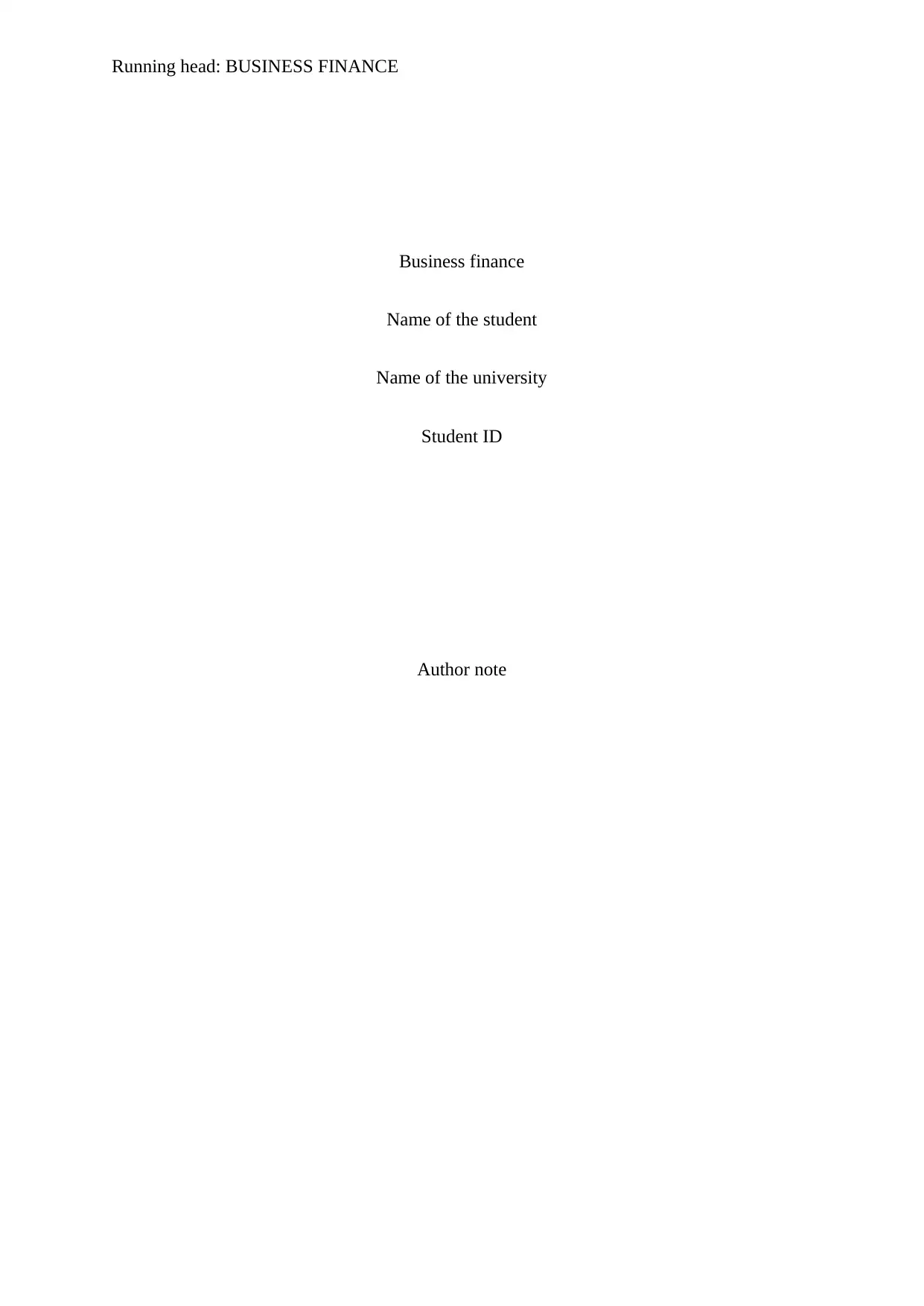
Running head: BUSINESS FINANCE
Business finance
Name of the student
Name of the university
Student ID
Author note
Business finance
Name of the student
Name of the university
Student ID
Author note
Paraphrase This Document
Need a fresh take? Get an instant paraphrase of this document with our AI Paraphraser
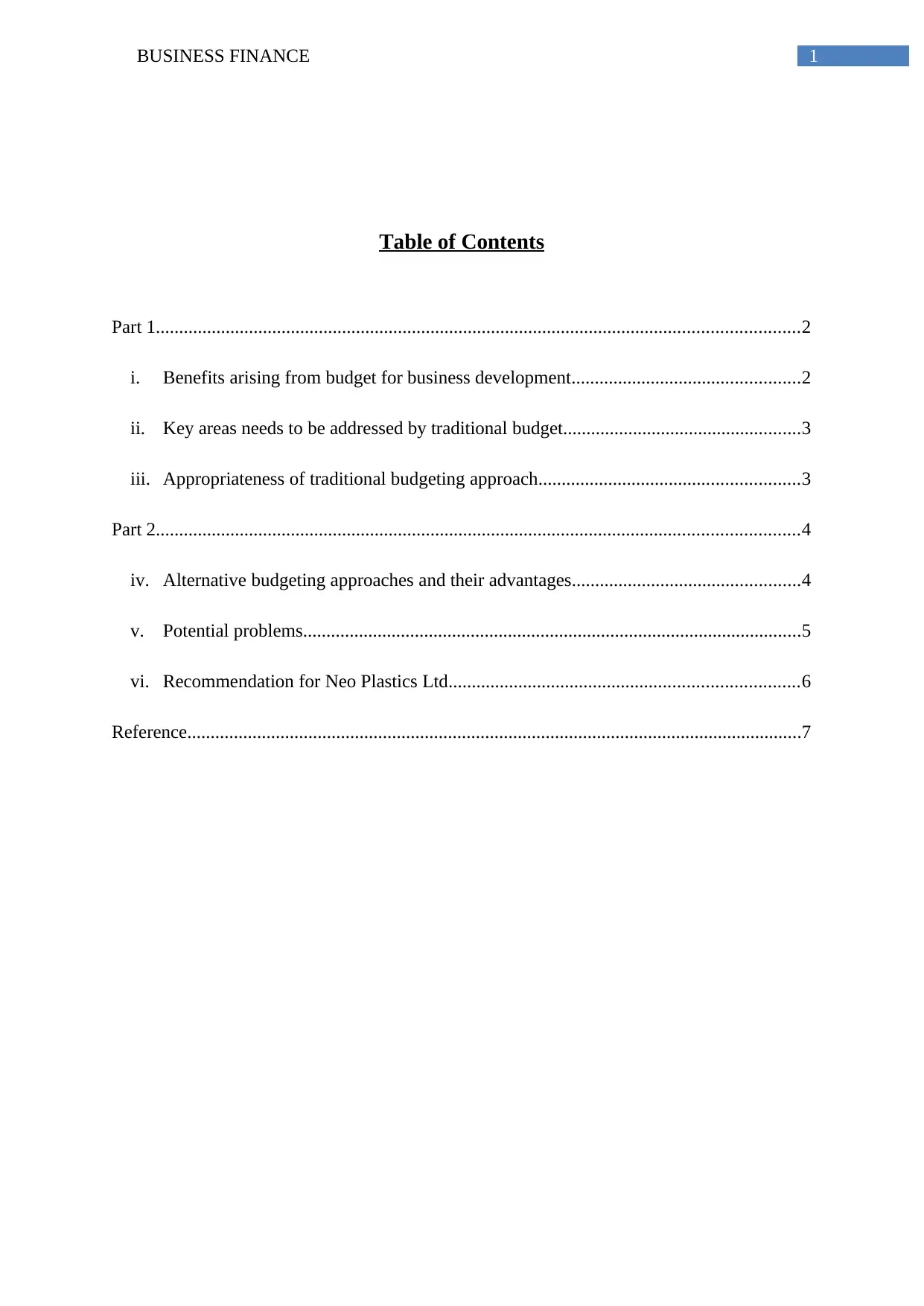
1BUSINESS FINANCE
Table of Contents
Part 1..........................................................................................................................................2
i. Benefits arising from budget for business development.................................................2
ii. Key areas needs to be addressed by traditional budget...................................................3
iii. Appropriateness of traditional budgeting approach........................................................3
Part 2..........................................................................................................................................4
iv. Alternative budgeting approaches and their advantages.................................................4
v. Potential problems...........................................................................................................5
vi. Recommendation for Neo Plastics Ltd...........................................................................6
Reference....................................................................................................................................7
Table of Contents
Part 1..........................................................................................................................................2
i. Benefits arising from budget for business development.................................................2
ii. Key areas needs to be addressed by traditional budget...................................................3
iii. Appropriateness of traditional budgeting approach........................................................3
Part 2..........................................................................................................................................4
iv. Alternative budgeting approaches and their advantages.................................................4
v. Potential problems...........................................................................................................5
vi. Recommendation for Neo Plastics Ltd...........................................................................6
Reference....................................................................................................................................7
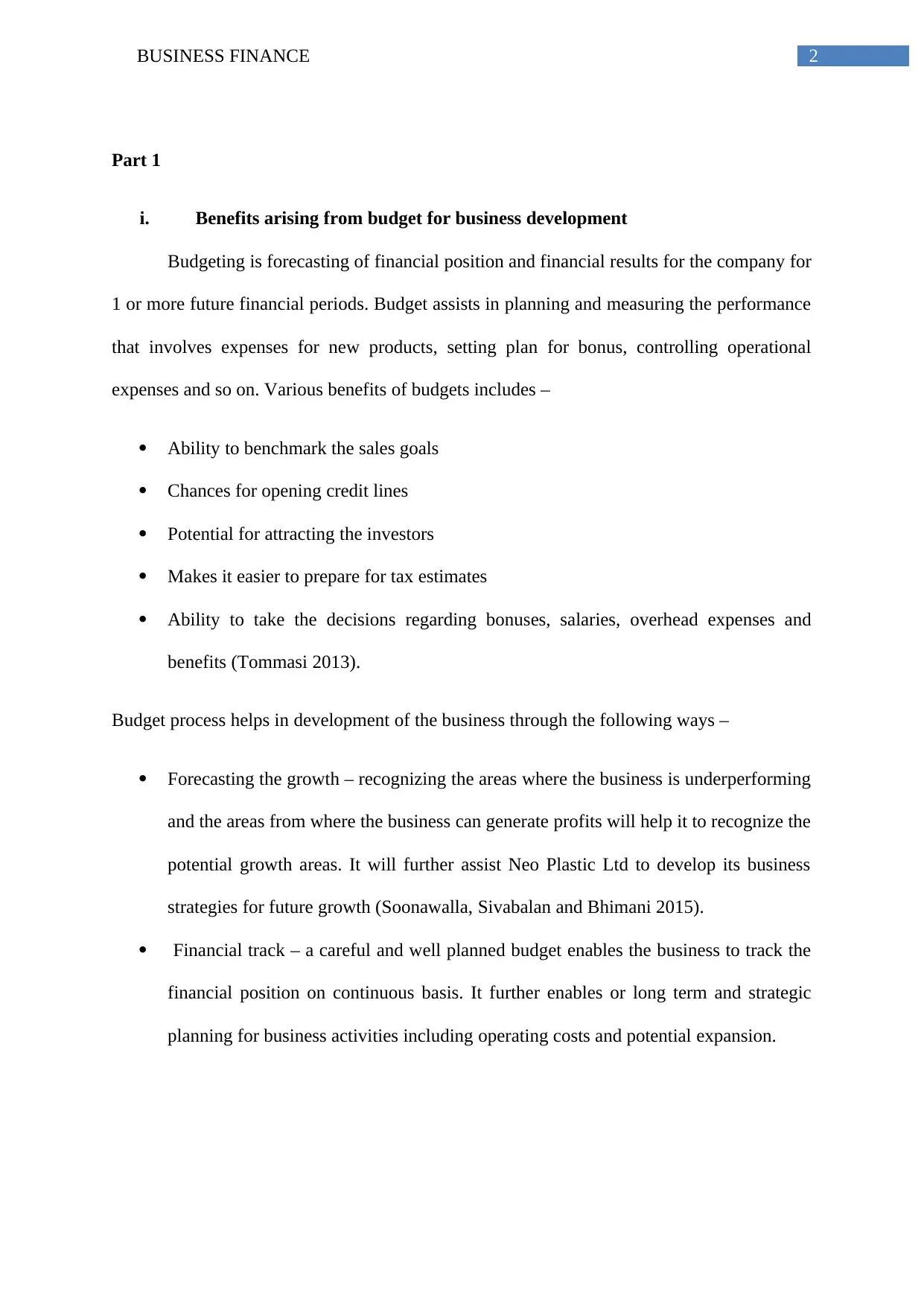
2BUSINESS FINANCE
Part 1
i. Benefits arising from budget for business development
Budgeting is forecasting of financial position and financial results for the company for
1 or more future financial periods. Budget assists in planning and measuring the performance
that involves expenses for new products, setting plan for bonus, controlling operational
expenses and so on. Various benefits of budgets includes –
Ability to benchmark the sales goals
Chances for opening credit lines
Potential for attracting the investors
Makes it easier to prepare for tax estimates
Ability to take the decisions regarding bonuses, salaries, overhead expenses and
benefits (Tommasi 2013).
Budget process helps in development of the business through the following ways –
Forecasting the growth – recognizing the areas where the business is underperforming
and the areas from where the business can generate profits will help it to recognize the
potential growth areas. It will further assist Neo Plastic Ltd to develop its business
strategies for future growth (Soonawalla, Sivabalan and Bhimani 2015).
Financial track – a careful and well planned budget enables the business to track the
financial position on continuous basis. It further enables or long term and strategic
planning for business activities including operating costs and potential expansion.
Part 1
i. Benefits arising from budget for business development
Budgeting is forecasting of financial position and financial results for the company for
1 or more future financial periods. Budget assists in planning and measuring the performance
that involves expenses for new products, setting plan for bonus, controlling operational
expenses and so on. Various benefits of budgets includes –
Ability to benchmark the sales goals
Chances for opening credit lines
Potential for attracting the investors
Makes it easier to prepare for tax estimates
Ability to take the decisions regarding bonuses, salaries, overhead expenses and
benefits (Tommasi 2013).
Budget process helps in development of the business through the following ways –
Forecasting the growth – recognizing the areas where the business is underperforming
and the areas from where the business can generate profits will help it to recognize the
potential growth areas. It will further assist Neo Plastic Ltd to develop its business
strategies for future growth (Soonawalla, Sivabalan and Bhimani 2015).
Financial track – a careful and well planned budget enables the business to track the
financial position on continuous basis. It further enables or long term and strategic
planning for business activities including operating costs and potential expansion.
⊘ This is a preview!⊘
Do you want full access?
Subscribe today to unlock all pages.

Trusted by 1+ million students worldwide
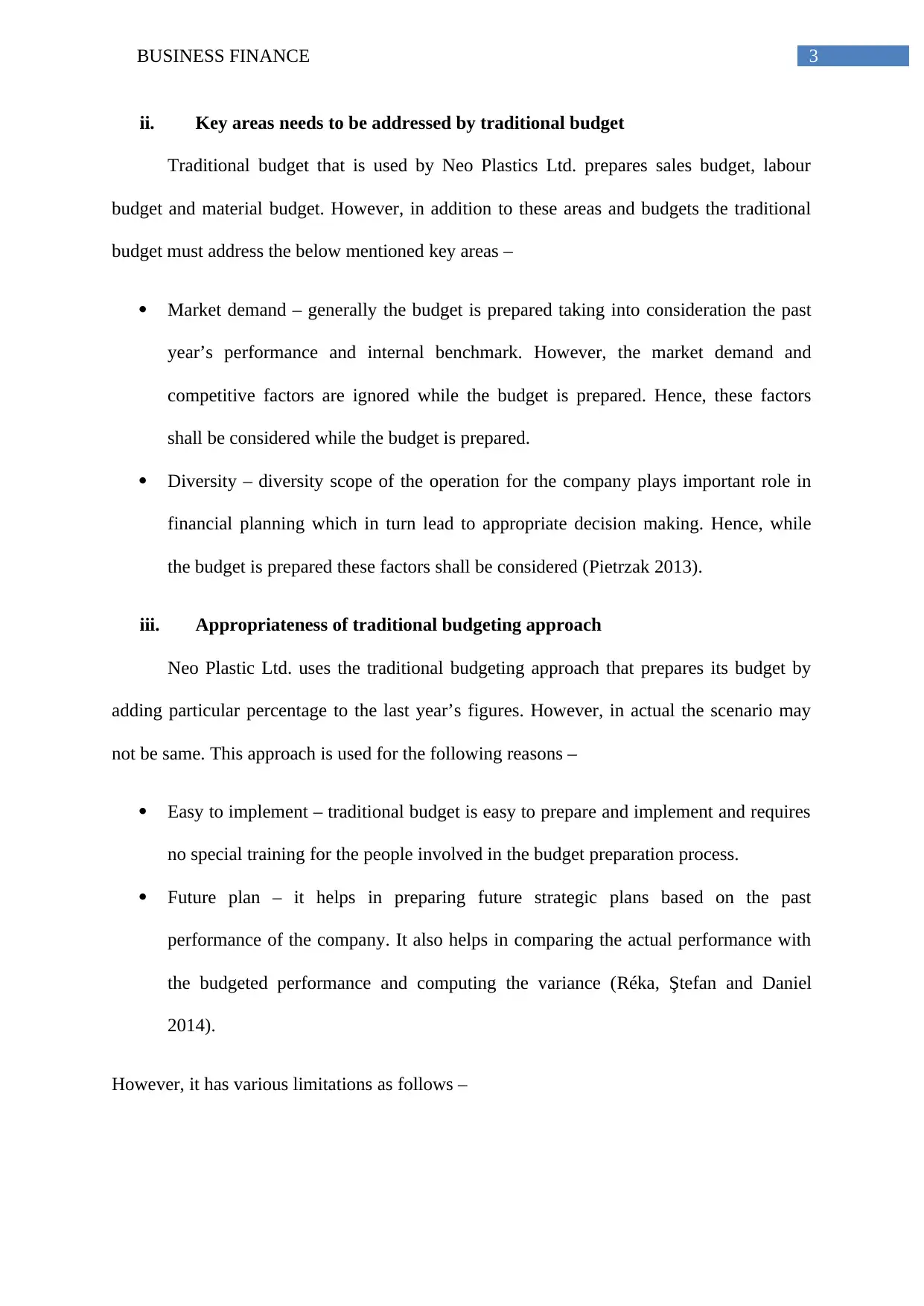
3BUSINESS FINANCE
ii. Key areas needs to be addressed by traditional budget
Traditional budget that is used by Neo Plastics Ltd. prepares sales budget, labour
budget and material budget. However, in addition to these areas and budgets the traditional
budget must address the below mentioned key areas –
Market demand – generally the budget is prepared taking into consideration the past
year’s performance and internal benchmark. However, the market demand and
competitive factors are ignored while the budget is prepared. Hence, these factors
shall be considered while the budget is prepared.
Diversity – diversity scope of the operation for the company plays important role in
financial planning which in turn lead to appropriate decision making. Hence, while
the budget is prepared these factors shall be considered (Pietrzak 2013).
iii. Appropriateness of traditional budgeting approach
Neo Plastic Ltd. uses the traditional budgeting approach that prepares its budget by
adding particular percentage to the last year’s figures. However, in actual the scenario may
not be same. This approach is used for the following reasons –
Easy to implement – traditional budget is easy to prepare and implement and requires
no special training for the people involved in the budget preparation process.
Future plan – it helps in preparing future strategic plans based on the past
performance of the company. It also helps in comparing the actual performance with
the budgeted performance and computing the variance (Réka, Ştefan and Daniel
2014).
However, it has various limitations as follows –
ii. Key areas needs to be addressed by traditional budget
Traditional budget that is used by Neo Plastics Ltd. prepares sales budget, labour
budget and material budget. However, in addition to these areas and budgets the traditional
budget must address the below mentioned key areas –
Market demand – generally the budget is prepared taking into consideration the past
year’s performance and internal benchmark. However, the market demand and
competitive factors are ignored while the budget is prepared. Hence, these factors
shall be considered while the budget is prepared.
Diversity – diversity scope of the operation for the company plays important role in
financial planning which in turn lead to appropriate decision making. Hence, while
the budget is prepared these factors shall be considered (Pietrzak 2013).
iii. Appropriateness of traditional budgeting approach
Neo Plastic Ltd. uses the traditional budgeting approach that prepares its budget by
adding particular percentage to the last year’s figures. However, in actual the scenario may
not be same. This approach is used for the following reasons –
Easy to implement – traditional budget is easy to prepare and implement and requires
no special training for the people involved in the budget preparation process.
Future plan – it helps in preparing future strategic plans based on the past
performance of the company. It also helps in comparing the actual performance with
the budgeted performance and computing the variance (Réka, Ştefan and Daniel
2014).
However, it has various limitations as follows –
Paraphrase This Document
Need a fresh take? Get an instant paraphrase of this document with our AI Paraphraser
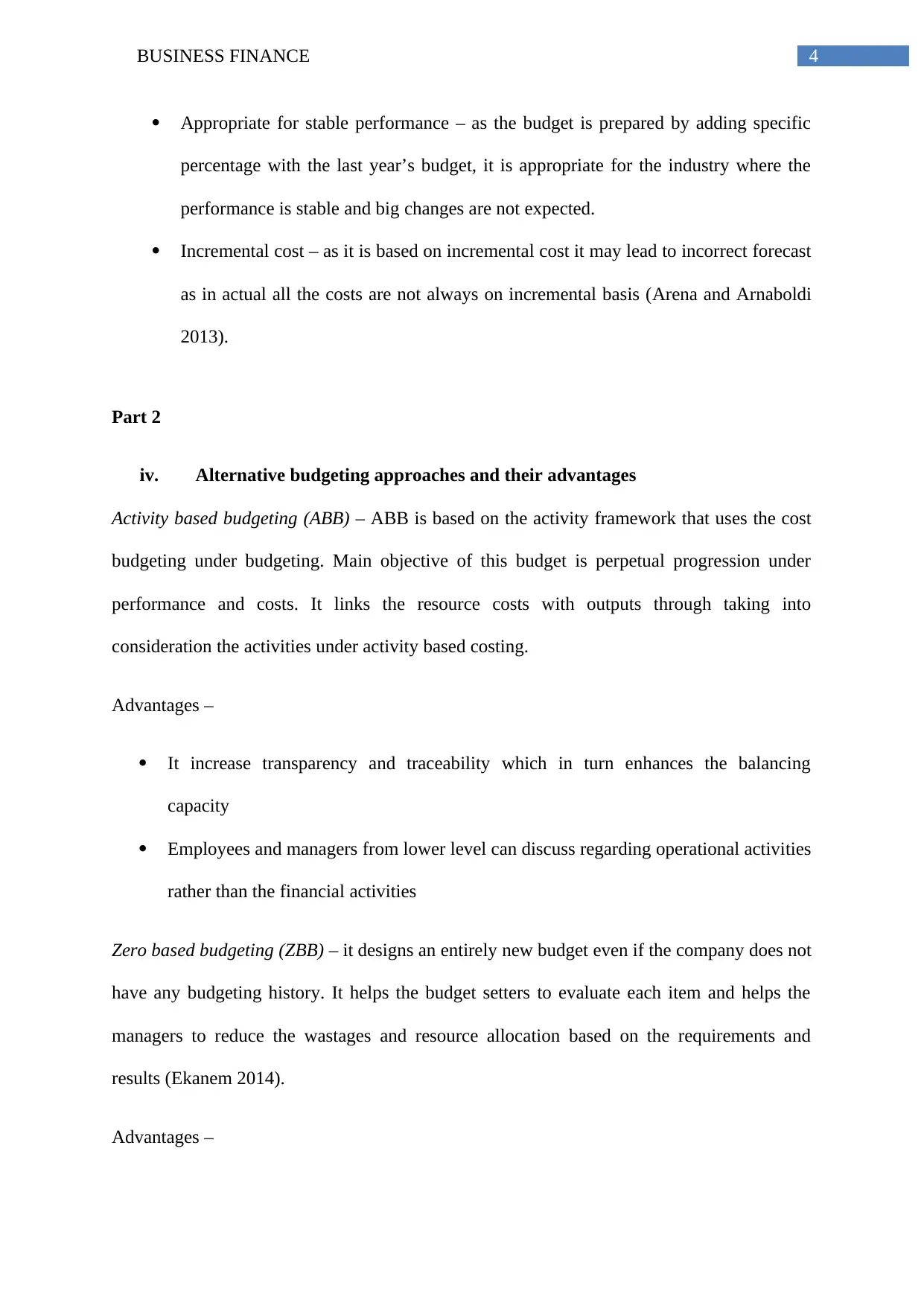
4BUSINESS FINANCE
Appropriate for stable performance – as the budget is prepared by adding specific
percentage with the last year’s budget, it is appropriate for the industry where the
performance is stable and big changes are not expected.
Incremental cost – as it is based on incremental cost it may lead to incorrect forecast
as in actual all the costs are not always on incremental basis (Arena and Arnaboldi
2013).
Part 2
iv. Alternative budgeting approaches and their advantages
Activity based budgeting (ABB) – ABB is based on the activity framework that uses the cost
budgeting under budgeting. Main objective of this budget is perpetual progression under
performance and costs. It links the resource costs with outputs through taking into
consideration the activities under activity based costing.
Advantages –
It increase transparency and traceability which in turn enhances the balancing
capacity
Employees and managers from lower level can discuss regarding operational activities
rather than the financial activities
Zero based budgeting (ZBB) – it designs an entirely new budget even if the company does not
have any budgeting history. It helps the budget setters to evaluate each item and helps the
managers to reduce the wastages and resource allocation based on the requirements and
results (Ekanem 2014).
Advantages –
Appropriate for stable performance – as the budget is prepared by adding specific
percentage with the last year’s budget, it is appropriate for the industry where the
performance is stable and big changes are not expected.
Incremental cost – as it is based on incremental cost it may lead to incorrect forecast
as in actual all the costs are not always on incremental basis (Arena and Arnaboldi
2013).
Part 2
iv. Alternative budgeting approaches and their advantages
Activity based budgeting (ABB) – ABB is based on the activity framework that uses the cost
budgeting under budgeting. Main objective of this budget is perpetual progression under
performance and costs. It links the resource costs with outputs through taking into
consideration the activities under activity based costing.
Advantages –
It increase transparency and traceability which in turn enhances the balancing
capacity
Employees and managers from lower level can discuss regarding operational activities
rather than the financial activities
Zero based budgeting (ZBB) – it designs an entirely new budget even if the company does not
have any budgeting history. It helps the budget setters to evaluate each item and helps the
managers to reduce the wastages and resource allocation based on the requirements and
results (Ekanem 2014).
Advantages –
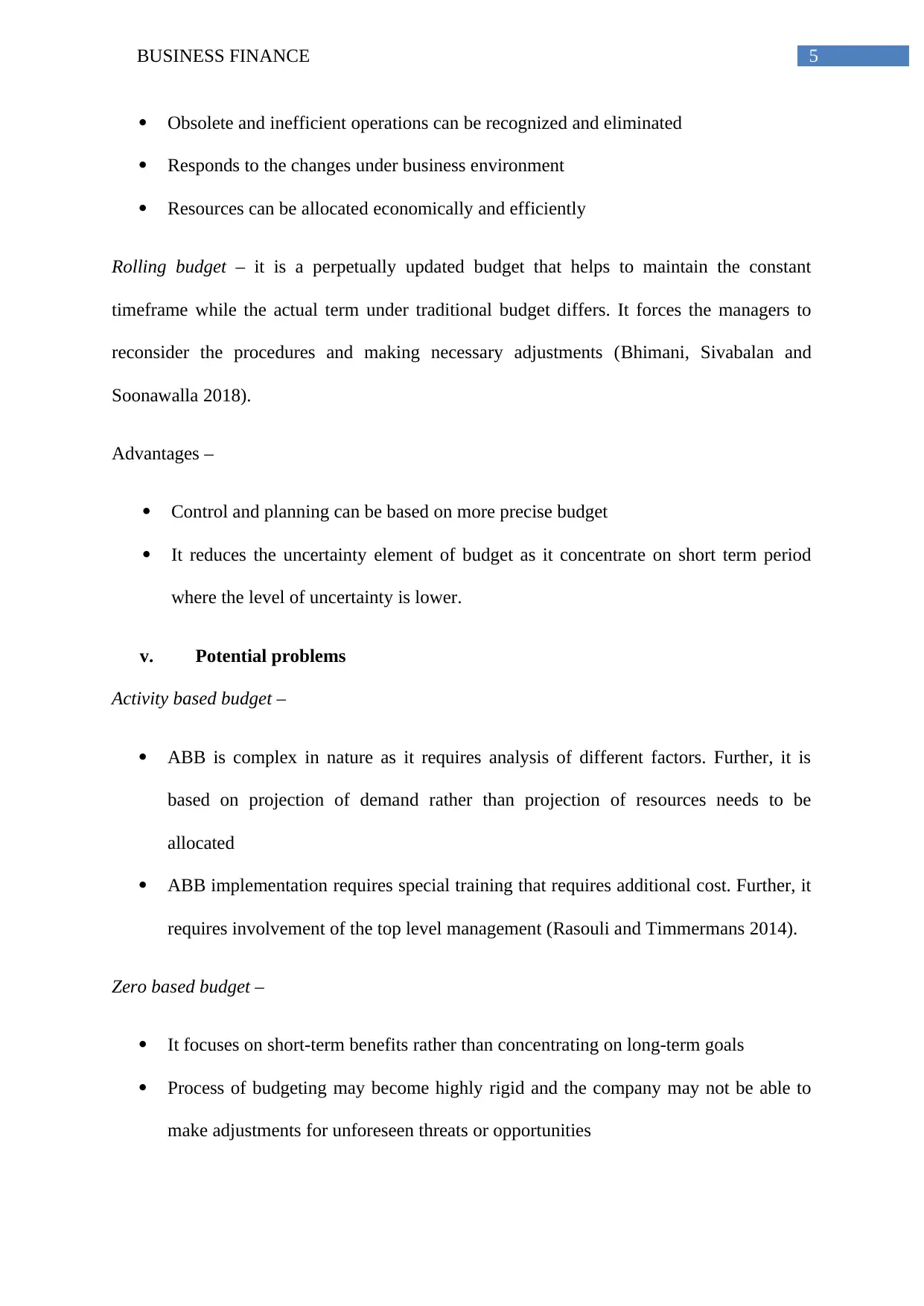
5BUSINESS FINANCE
Obsolete and inefficient operations can be recognized and eliminated
Responds to the changes under business environment
Resources can be allocated economically and efficiently
Rolling budget – it is a perpetually updated budget that helps to maintain the constant
timeframe while the actual term under traditional budget differs. It forces the managers to
reconsider the procedures and making necessary adjustments (Bhimani, Sivabalan and
Soonawalla 2018).
Advantages –
Control and planning can be based on more precise budget
It reduces the uncertainty element of budget as it concentrate on short term period
where the level of uncertainty is lower.
v. Potential problems
Activity based budget –
ABB is complex in nature as it requires analysis of different factors. Further, it is
based on projection of demand rather than projection of resources needs to be
allocated
ABB implementation requires special training that requires additional cost. Further, it
requires involvement of the top level management (Rasouli and Timmermans 2014).
Zero based budget –
It focuses on short-term benefits rather than concentrating on long-term goals
Process of budgeting may become highly rigid and the company may not be able to
make adjustments for unforeseen threats or opportunities
Obsolete and inefficient operations can be recognized and eliminated
Responds to the changes under business environment
Resources can be allocated economically and efficiently
Rolling budget – it is a perpetually updated budget that helps to maintain the constant
timeframe while the actual term under traditional budget differs. It forces the managers to
reconsider the procedures and making necessary adjustments (Bhimani, Sivabalan and
Soonawalla 2018).
Advantages –
Control and planning can be based on more precise budget
It reduces the uncertainty element of budget as it concentrate on short term period
where the level of uncertainty is lower.
v. Potential problems
Activity based budget –
ABB is complex in nature as it requires analysis of different factors. Further, it is
based on projection of demand rather than projection of resources needs to be
allocated
ABB implementation requires special training that requires additional cost. Further, it
requires involvement of the top level management (Rasouli and Timmermans 2014).
Zero based budget –
It focuses on short-term benefits rather than concentrating on long-term goals
Process of budgeting may become highly rigid and the company may not be able to
make adjustments for unforeseen threats or opportunities
⊘ This is a preview!⊘
Do you want full access?
Subscribe today to unlock all pages.

Trusted by 1+ million students worldwide
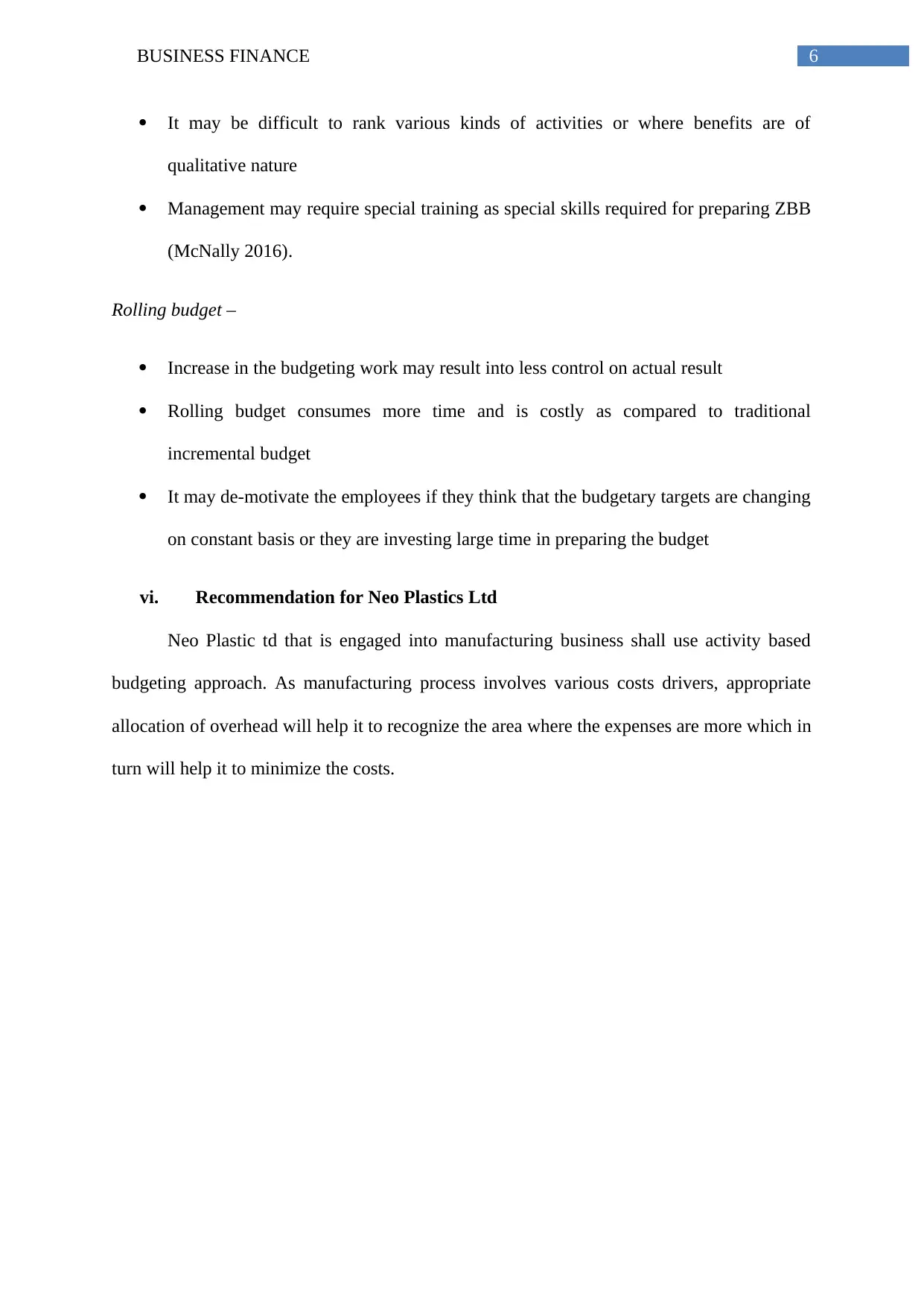
6BUSINESS FINANCE
It may be difficult to rank various kinds of activities or where benefits are of
qualitative nature
Management may require special training as special skills required for preparing ZBB
(McNally 2016).
Rolling budget –
Increase in the budgeting work may result into less control on actual result
Rolling budget consumes more time and is costly as compared to traditional
incremental budget
It may de-motivate the employees if they think that the budgetary targets are changing
on constant basis or they are investing large time in preparing the budget
vi. Recommendation for Neo Plastics Ltd
Neo Plastic td that is engaged into manufacturing business shall use activity based
budgeting approach. As manufacturing process involves various costs drivers, appropriate
allocation of overhead will help it to recognize the area where the expenses are more which in
turn will help it to minimize the costs.
It may be difficult to rank various kinds of activities or where benefits are of
qualitative nature
Management may require special training as special skills required for preparing ZBB
(McNally 2016).
Rolling budget –
Increase in the budgeting work may result into less control on actual result
Rolling budget consumes more time and is costly as compared to traditional
incremental budget
It may de-motivate the employees if they think that the budgetary targets are changing
on constant basis or they are investing large time in preparing the budget
vi. Recommendation for Neo Plastics Ltd
Neo Plastic td that is engaged into manufacturing business shall use activity based
budgeting approach. As manufacturing process involves various costs drivers, appropriate
allocation of overhead will help it to recognize the area where the expenses are more which in
turn will help it to minimize the costs.
Paraphrase This Document
Need a fresh take? Get an instant paraphrase of this document with our AI Paraphraser
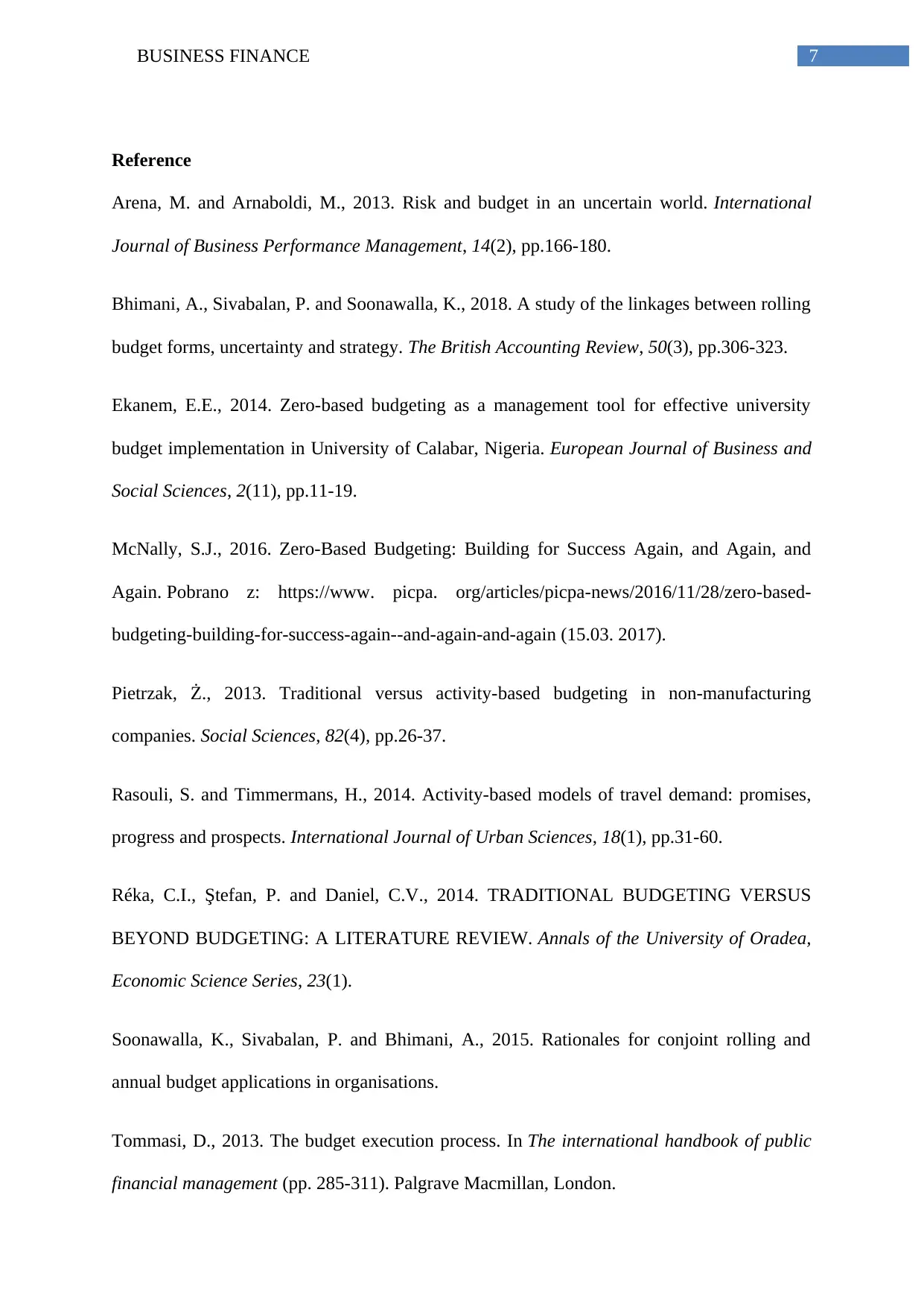
7BUSINESS FINANCE
Reference
Arena, M. and Arnaboldi, M., 2013. Risk and budget in an uncertain world. International
Journal of Business Performance Management, 14(2), pp.166-180.
Bhimani, A., Sivabalan, P. and Soonawalla, K., 2018. A study of the linkages between rolling
budget forms, uncertainty and strategy. The British Accounting Review, 50(3), pp.306-323.
Ekanem, E.E., 2014. Zero-based budgeting as a management tool for effective university
budget implementation in University of Calabar, Nigeria. European Journal of Business and
Social Sciences, 2(11), pp.11-19.
McNally, S.J., 2016. Zero-Based Budgeting: Building for Success Again, and Again, and
Again. Pobrano z: https://www. picpa. org/articles/picpa-news/2016/11/28/zero-based-
budgeting-building-for-success-again--and-again-and-again (15.03. 2017).
Pietrzak, Ż., 2013. Traditional versus activity-based budgeting in non-manufacturing
companies. Social Sciences, 82(4), pp.26-37.
Rasouli, S. and Timmermans, H., 2014. Activity-based models of travel demand: promises,
progress and prospects. International Journal of Urban Sciences, 18(1), pp.31-60.
Réka, C.I., Ştefan, P. and Daniel, C.V., 2014. TRADITIONAL BUDGETING VERSUS
BEYOND BUDGETING: A LITERATURE REVIEW. Annals of the University of Oradea,
Economic Science Series, 23(1).
Soonawalla, K., Sivabalan, P. and Bhimani, A., 2015. Rationales for conjoint rolling and
annual budget applications in organisations.
Tommasi, D., 2013. The budget execution process. In The international handbook of public
financial management (pp. 285-311). Palgrave Macmillan, London.
Reference
Arena, M. and Arnaboldi, M., 2013. Risk and budget in an uncertain world. International
Journal of Business Performance Management, 14(2), pp.166-180.
Bhimani, A., Sivabalan, P. and Soonawalla, K., 2018. A study of the linkages between rolling
budget forms, uncertainty and strategy. The British Accounting Review, 50(3), pp.306-323.
Ekanem, E.E., 2014. Zero-based budgeting as a management tool for effective university
budget implementation in University of Calabar, Nigeria. European Journal of Business and
Social Sciences, 2(11), pp.11-19.
McNally, S.J., 2016. Zero-Based Budgeting: Building for Success Again, and Again, and
Again. Pobrano z: https://www. picpa. org/articles/picpa-news/2016/11/28/zero-based-
budgeting-building-for-success-again--and-again-and-again (15.03. 2017).
Pietrzak, Ż., 2013. Traditional versus activity-based budgeting in non-manufacturing
companies. Social Sciences, 82(4), pp.26-37.
Rasouli, S. and Timmermans, H., 2014. Activity-based models of travel demand: promises,
progress and prospects. International Journal of Urban Sciences, 18(1), pp.31-60.
Réka, C.I., Ştefan, P. and Daniel, C.V., 2014. TRADITIONAL BUDGETING VERSUS
BEYOND BUDGETING: A LITERATURE REVIEW. Annals of the University of Oradea,
Economic Science Series, 23(1).
Soonawalla, K., Sivabalan, P. and Bhimani, A., 2015. Rationales for conjoint rolling and
annual budget applications in organisations.
Tommasi, D., 2013. The budget execution process. In The international handbook of public
financial management (pp. 285-311). Palgrave Macmillan, London.

8BUSINESS FINANCE
⊘ This is a preview!⊘
Do you want full access?
Subscribe today to unlock all pages.

Trusted by 1+ million students worldwide
1 out of 9
Related Documents
Your All-in-One AI-Powered Toolkit for Academic Success.
+13062052269
info@desklib.com
Available 24*7 on WhatsApp / Email
![[object Object]](/_next/static/media/star-bottom.7253800d.svg)
Unlock your academic potential
Copyright © 2020–2025 A2Z Services. All Rights Reserved. Developed and managed by ZUCOL.




